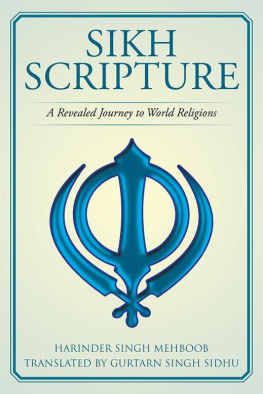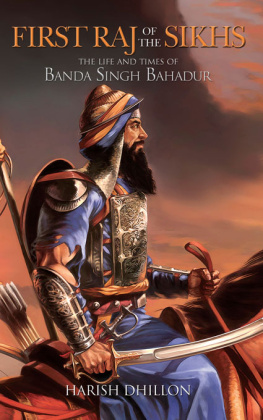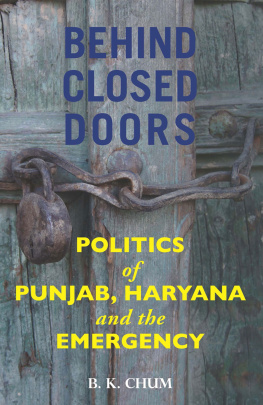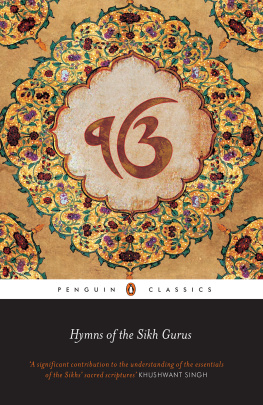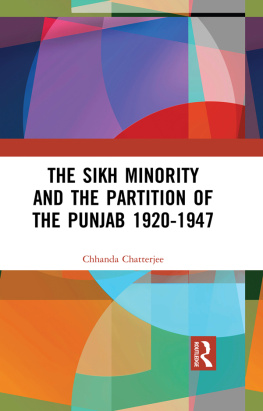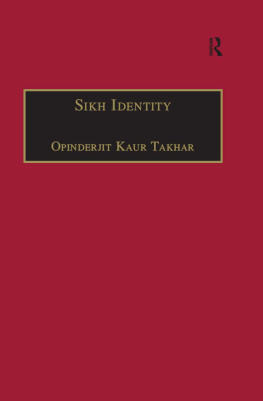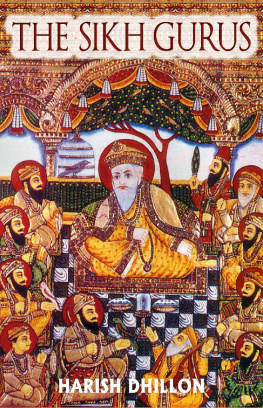RELIGIOUS PLURALISM IN PUNJAB
Religious Pluralism in Punjab
A Contemporary Account of Sikh Sants, Babas, Gurus and Satgurus
JOGINDER SINGH
First published 2018
by Routledge
2 Park Square, Milton Park, Abingdon, Oxon OX14 4RN
and by Routledge
711 Third Avenue, New York, NY 10017, USA
Routledge is an imprint of the Taylor & Francis Group, an informa business
2018 Joginder Singh and Manohar Publishers & Distributors
The right of Joginder Singh to be identified as author of this work has been asserted by him in accordance with sections 77 and 78 of the Copyright, Designs and Patents Act 1988.
All rights reserved. No part of this book may be reprinted or reproduced or utilised in any form or by any electronic, mechanical, or other means, now known or hereafter invented, including photocopying and recording, or in any information storage or retrieval system, without permission in writing from the publishers.
Trademark notice: Product or corporate names may be trademarks or registered trademarks, and are used only for identification and explanation without intent to infringe.
Print edition not for sale in South Asia (India, Sri Lanka, Nepal, Bangladesh, Pakistan or Bhutan).
British Library Cataloguing in Publication Data
A catalogue record for this book is available from the British Library
Library of Congress Cataloging in Publication Data
A catalog record for this book has been requested
ISBN: 978-1-138-28064-9 (hbk)
ISBN: 978-1-315-27186-6 (ebk)
Typeset in Janson Text 11/13
by Kohli Print, Delhi 110 051
Contents
There are a large number of Sants/Babas, Mahants/Pujaris, Pirs/Faqirs, Sadhus and Gurus who run akharas, ashrams (monastic orders), deras/taksals (seminaries), maths (Hindu monasteries)/mandirs, gurdwaras/dharamsalas and khanqahs/mazars (shrines or tombs of Muslim saints) in the Punjab.1 These religious leaders perform multiple duties and functions which relate to the control and management of the seminaries and their properties, making arrangements for the propagation of their respective missions, observing codes of conduct and addressing to the problems of the devotees.2 These holymen enjoy spiritual and temporal status and hegemonic control over their respective followers. All political parties including government, a substantial section of professionals, administrative personnel and intellectuals patronize these holymen. In return, the holymen serve their patrons in different forms. They maintain their private armies and often flout law and order, even confront the state. Several sants and babas have transformed their respective deras into their personal estates. Ideally speaking, they are supposed to be holy persons of piety and virtue and are expected to lead a life of contemplation and rigorous denial. Moreover, they are supposed to work for the promotion of spiritual betterment of the people. However, both print and television media has exposed the unholy and criminal records of several sants and babas. Very recently the Punjab and Haryana High Court was seized of the serious law and order implications for the state as well as civil society.3
A large number of contemporary holymen and their followers come from diverse social and religious backgrounds. The Muslims of the British Punjab have left a legacy of religious establishments of pirs and faqirs: Sakhi Sarvars, Panj Pirs, Gugga Pirs and Sufi saints. The latter are more revered by the Sikhs and Hindus than the former since the verses of several prominent sants and babas in Punjabi language are cherised by the Punjabis for depicting profane as well as sacred reality. Moreover, they expose the shallowness of ritualism and hypocrisy of the priestly classes. At the same time, they preach a path to attain union with the Almighty. Sufis like Sultan Bahu and Bulleh Shah gave expression to their devotional moods and inner experiences in songs that still are sung by peasants as well as professional qawals.4 On the other hand, the religious places of the Sakhi Sarvars, Panj Pirs and Gugga Pirs personify supernatural powers and invoke fear among the mortals. Consequently, these establishments now serve as centres of folk religion and culture. Excepting the establishment of the Ahmadiyas and shrines of Malerkotla, the establihsments of the Muslim saints are managed by non-Muslims, principally Sikhs. As we shall note, the working of establishments like Seikhphatta (Jandiala Guru, Amritsar) has clearly demonstrated that the temporal aspirations play a dominant role as compared to religious affiliations in the social life. At the same time, the emergence of so-called Sufi centres like Sanjha Darbar, Kantian Shariff (Hoshiarpur) and revival of worship of dargahs and tombs indicate that the marginalized people or people suffering from physical and psychological problems often pay their obeisance at these places and seek relief. They also seek psychological protection to ward off any unpleasant happenings in the future and aspire to be blessed with prosperity.
Similarly, several streams of Hindu holymen and their followers are popular in Punjab. The first stream comprises mahants, pujaris, sants, babas, bhagats and yogis who are either custodians or trustees of the historical temples of gods and goddesses, deras and ashrams. The gods and goddesses personify various forms of Almighty God. Their devotees perform prescribed rituals and customs for fulfilling their aspirations. Closely related to them are deras and ashrams of yogis and babas like Bawa Lal of Dhianpur, Baba Sodal of Jalandhar and the ashram of Pandori Mahantan in Gurdaspur. Their devotees, largely Hindus, often pay their homage at these establishments and stay for some nights for performing rituals prescribed by the priests. Another stream of the holymen comprises modern exponents of different schools of Hinduism. They hold huge satsangs, perform katha and kirtan. They also exhort their followers to meditate on the name of God. However, the temples under the custody of leaders and activists of Hindu organizations use religious places for generating and spreading sectarian Hindu consciousness among the people. The largest followers of these modern exponents are urban Hindus.
There is another category of holymen and their followers who represent composite beliefs and practices of Hinduism and Sikhism. They are Udasis, Minas, Ramraias, Handalis, Dhirmalias, Gulabdasis and Nirmalas. The Minas, Ramraias, Handalis and Dhirmalias tried to establish parallel gaddis to the Sikh Gurus and composed their banis demeaning of Sikh traditions. For the contemporary Sikhs they were no more than reprobates. However, now they have either tilted towards Hinduism or Sikhism. Their establishments attract both Hindus and Sikhs. The founders of these cults are known for possessing supernatural powers. Nevertheless, the proliferation of Sikh sants and



